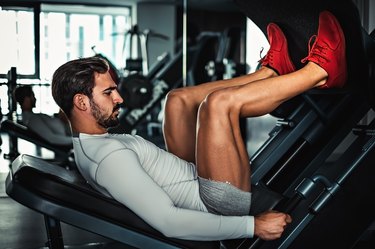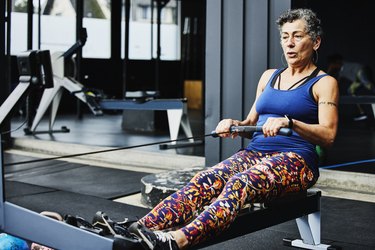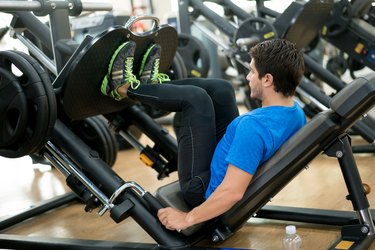

Whether you're looking to improve your deadlift or hip thrust technique, working out with weights isn't the only way you can hone in on your form and become more powerful in your lifts.
Using popular lower body–focused exercise machines, like the rower and leg press, will help you emphasize proper form while helping you build strength, endurance and explosiveness. That last bit is particularly key if you want to have more powerful and heavier lifts.
Video of the Day
Video of the Day
Ahead, experts share which leg exercise machines can improve your lower-body lifts and how to use them effectively.
1. Rowing Machine for Deadlifts

The rowing machine is often thought of as a more upper body–focused workout, but it's a great way to complement your deadlift training. It reinforces the explosive hinging and driving through your legs that's imperative for a successful deadlift, Carlos Davila, CPT, an instructor at Fhitting Room, a HIIT and strength training studio in New York City and New Jersey, says.
That's because when you're rowing, you're pressing your feet into the footpads to drive each stroke through your legs. At the same time, you're using your arms to pull the handle. This is the same type of movement you do when you deadlift: Pressing your feet into the ground, you're imagining that you're pushing the floor away from you as you pull the weight up.
"Rowing also builds muscles in the lower body and posterior chain, both used when deadlifting," Davila says.
In addition to the rower, the ski erg machine, which mimics alpine skiing in real life, can be beneficial for deadlift training.
"The ski erg also teaches the hinge, but the emphasis is on an explosive downward hinge (versus the explosive upward hinge used in the deadlift). The utilization of quads, glutes, hamstrings, back extensors and abdominals in this movement also makes it an ideal cardio machine to use for deadlift training," Davila says.
How to Use the Rower to Complement Your Deadlift Training
Do short intervals of rowing. For example, do one minute of rowing for max meters followed by one minute off for five rounds, Eric Salvador, CPT, head instructor at the Fhitting Room, says. "Short, all-out sprints work on power output. This is a great way to transfer gains on the deadlift to power on the rower."
2. Seated Leg Press for Back Squats

The seated leg press is an excellent way to enhance your back squat technique because it trains you to apply even pressure on your feet to emphasize your quads or glutes, Andrew Watkins, CPT, director of strength and conditioning at Sports Performance Lab, says.
"The leg press can take the stress off an individual's lower back and allow focus on the leg drive. Having stronger quads and glutes has a direct impact on a person's squat," he explains.
When you're doing a seated leg press, your back and hips are flat against the seat and you're bending your knees to 90 degrees while bracing your core. By pressing your feet against the platform, you're driving the weight with your legs. Hence, it primarily strengthens your quads and glutes.
How to Use the Seated Leg Press to Improve Your Back Squats
You can change up which muscle group you're targeting more on the seated leg press by simply changing your foot position.
"Learn to use the platform to your advantage. This comes down to knowing your weaknesses. Do you feel that your quads could be stronger or need more emphasis on your glutes? Your foot placement can make all the difference," Watkins says.
Turning out your toes and placing your feet toward the top of the platform emphasizes your glutes, while having a narrower stance and pushing through the middle of the footplate will target more of your quads, Watkins says.
3. Hip Thrust Machine for Barbell Hip Thrusts

While not every gym will have a hip thrust machine, this underrated fitness tool can be helpful in nailing down the lift without worrying about balancing the barbell on your hips. This helps you focus on contracting your glutes at the top of the movement and lowering your hips down with control.
"A key component of the hip thrust is to have control throughout the range of motion, holding a good contraction at the top and lowering the pad slowly through the eccentric phase of the lift. This will ensure proper tempo and yield strong results. As a person becomes more aware of how to activate proper neural pathways and contracts properly, they can advance to barbell hip thrusts," Watkins says.
How to Use the Hip Thrust Machine to Improve Your Barbell Hip Thrust
Your setup for the hip thrust machine is crucial for an effective lift. You want to have both feet flat on the foot platform directly under your knees. Before you initiate the hip drive, make sure to brace your core and engage your glutes.
"Keep the spine in a strong stable position as you approach the top range of motion by posteriorly rotating your hips and slightly crunching your abs. Another training cue is to keep the chin slightly aimed down. This will ensure that you are braced properly and help prevent hyperextending the lower back," Watkins says.
Once you're at the top of the movement, you want to pause. This helps ensure that your glutes are loading, he says. Then, slowly lower your hips back down.
4. Smith Machine for Front Squats

The Smith machine is a great alternative to a barbell front squat for those who lack shoulder or wrist mobility or have an injury. But it's also an excellent tool for understanding the natural movement pattern of the front squat.
"Front squats are more of a quad-dominant lift compared to the back squat based on bar path and position," Watkins says. It also activates some of your upper-body muscles, such as your trapezius and rhomboid (upper back muscles) to keep the bar in position.
"Most people struggle or even fail at this lift due to upper body breakdown or weaknesses. This is where the Smith machine shines because you can work on leg drive, which gives [you] an opportunity to understand and feel the weight without having to focus as intensely on balance," Watkins says.
How to Use the Smith Machine to Improve Your Front Squats
Front squats are usually performed with the barbell in the front-rack position with the bar resting above your shoulders, which can sometimes be uncomfortable.
"The Smith machine helps simplify the exercise and help target weak quads with less weight than a back squat. Always remember to engage the core and work on learning to lower yourself down in a controlled fashion. Pause slightly at the bottom of each rep and use the entire body together to stand up safely," Watkins says.
5. Glute-Ham Developer for Squats and Deadlifts

Also known as the GHD, the glute-ham developer is one of the best lower-body machines for strengthening your glutes and hamstrings. Thus, it's a great tool for strengthening your squats and deadlifts.
"The stronger we become in the posterior chain with proper balance points the more efficient we can become overall," Watkins says.
The GHD gets your body into a position that isolates your glutes and hamstrings, helping you learn how to activate them, especially for lower-body lifts that require you to bend at the waist.
This machine is good for learning how to properly contract your glutes and hamstrings when doing a heavy deadlift or back squat so that your pelvis and lower back stay safe and stable.
How to Use the Glute-Ham Developer to Improve Your Squats and Deadlifts
Although the GHD might look like a complicated machine, it's actually pretty simple to use. You lie face-down (prone) so that the padding is just within your hip crease and hook your feet to the attachments. You can adjust how far away the handles are from you, depending on your height.
Start kneeling on the pad and hook your feet to the attachment behind you with your toes pointing toward the floor. Cross your arms in front of your chest or keep your hands behind your head. Hinging from your knees, lower your torso toward the floor with control until it's parallel to the ground. Contract your glutes and hamstrings as you lift your torso back up.